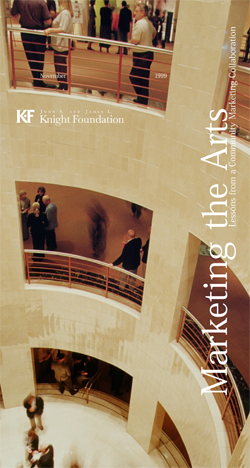Non-profit management
March 2000, 29 pages, executive summary; 126 pages, narrative report. ArtsMarket. Copies are available from Walter and Elise Haas Fund, One Lombard Street, Suite 305, San Francisco, California 94111, (415) 398-4474.
Read More...Executive Summary and Report
Based on interviews by Morrie Warshawski and Dinah Zeiger
Contributors to preparation and editing: Sonja K. Foss, Krista Lewis, Glynis Jones, Daniel Buehler, and Daisy Whitney
1999, 54 pages; Western States Arts Federation (WESTAF), Denver, Colorado, 303-629-1166.
Read More...Strategic restructuring is a term increasingly used to refer to a broad continuum of options for organizational partnerships, including but not limited to mergers, asset transfers, joint ventures, administrative or back office consolidations, joint programs, parent-subsidiary structures, and fiscal sponsorships. Such restructuring is often undertaken by nonprofits in an attempt to anticipate or respond to environmental threats and opportunities.
Read More...National Arts Stabilization (NAS) offered the first course in its executive education program in 1997. Originally called Strategic Leadership in a Changing Environment, Strategy is a three-day seminar that, according to the NAS website, provides arts leaders with "a framework for understanding how to:
- analyze the competitive environment,
- identify alternative strategies, and
- integrate mission and strategy."
Quarterly; nonprofit North American subscription rates vary according to budget size and the exchange rate ($104-$156); Henry Stewart Publications, Russell House, London, United Kingdom.
Read More...November 1999, 48 pages; John S. and James L. Knight Foundation, Miami, Florida.
Download:
Read More...I have had, with my friend Wes Jackson, a number of useful conversations about the necessity of getting out of movements — even movements that have seemed necessary and dear to us — when they have lapsed into self-righteousness and self-betrayal, as movements seem almost invariably to do. People in movements too readily learn to deny to others the rights and privileges they demand for themselves. They too easily become unable to mean their own language, as when a “peace movement” becomes violent.
Read More...One summer weekend several years ago, the psychiatrist husband of a dear friend of mine remarked over the dinner table how emotionally healthy his two weekend guests were. "We've taken you through all sorts of things you've never done before, and you've leaped into everything with no fear. You take risks and cope with whatever happens, whether good or bad. It's so impressive!" We looked at him over the tops of our wine glasses and said, "Oh, this is so sad. You've been with sick people for way too long."
Read More...Why are you engaged in your current field of work? What significant lessons have you learned along the way? These are questions we ask of applicants to the Durfee Foundation's Sabbatical program, an initiative that provides "time off" to leaders in the nonprofit sector in Los Angeles. Sadly, arts applicants to the program have had difficulty providing compelling answers. By and large, their attempts to explain their commitment to their chosen field have been weak, particularly in comparison to their peers in the social services.
Read More...As the Twentieth Century approaches a finale, the arts in America exist in a vast array of styles, disciplines and organizational structures. The purpose here is to examine one major organizational component of the American arts scene, the nonprofit sector, as an organic system that has progressed through three distinct stages over the past century.
Read More...
